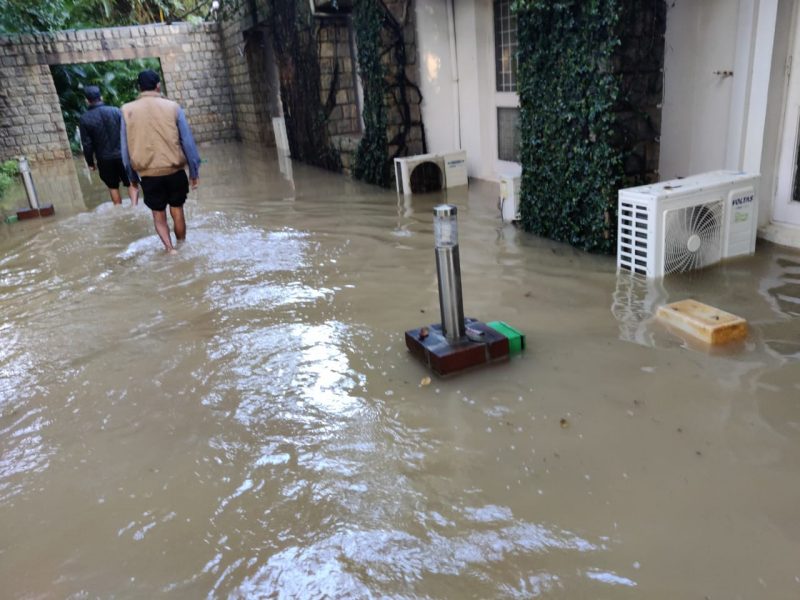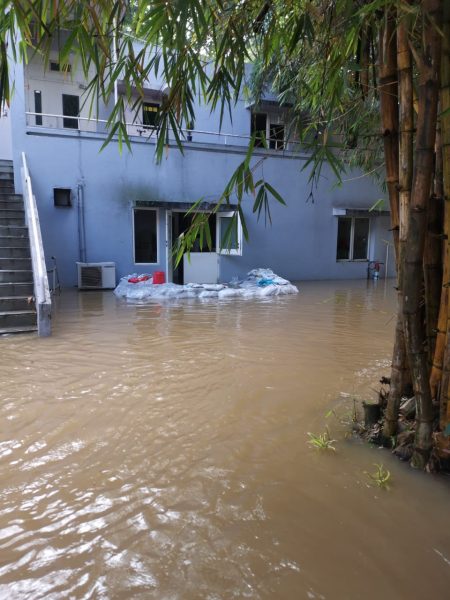
After deluge, scientists at top Bangalore institute count the cost

Last Friday, scientists at one of Bangalore’s top research institutes, Jawaharlal Nehru Centre for Advanced Scientific Research (JNCASR), were scurrying to put in place a sandbag barrier at the entrance to their Molecular Biology and Genetics Unit (MBGU) where decades’ long collections of research samples and reagents were stored in cryogenic and deep freezers. These included labs known for their work on stem cells and in HIV and where, like any scientific workplace, ‘contamination’ is a dreaded word. Their immediate worry, of course, was the incessant rain that had been beating down on the city for weeks.
“We did a solid job,” recounts Ravi Manjithaya, associate professor at MBGU, who was among those co-ordinating the task that involved ferrying in the sand on tractors, sewing up the bags and sealing the barrier with plastic sheets. But just two nights later, on November 21, about 153mm of rain came bucketing down on the North Bangalore locality of Jakkur where JNCASR is located – putting to nought that stop-gap effort and leaving the laboratories on lower ground full of water and filth.
By mid-week, on November 24, the water had receded and the institute now faces the onerous task of cleaning up and restoring its equipment. It takes years to set up a full-fledged lab with the minus 80 degree freezers, biosafety level cabinets, incubators and state-of-the-art machines such as cell sorters. “All of that just came under water,” says Manjithaya. “First of all, we don’t know what the extent of loss is and the second thing is that, even if we salvage some of the samples, how much time and effort are we going to spend in just checking every single sample.”
“The power systems, internet, telephone connections, everything has to be re-done,” says Jayachandra A N, an advisor with JNCASR’s estate unit. “It will take about a week for us to know what the loss is.”
Also read: How prolonged rain in Karnataka is ruining your favourite brew
The biological sciences unit – which houses the HIV laboratory headed by Prof Ranga Udaykumar and the stem cell lab of MBGU chairperson Prof Maneesha Inamdar – were among those that took the brunt of the downpour because it was on lower ground and close to the canal. But when the rainwater came gushing in, power had to be switched off as a precautionary measure thereby affecting many other labs as well.

Prof Udaykumar says the sandbags piled up outside his lab indeed worked well. “But we totally forgot there was a drain line into the main lab and water entered through the drain line. Otherwise, we could have saved our HIV lab.”
This lab is among the few places globally that study the virus subtype C, which is the most prevalent form of HIV in India and which accounts for nearly half of the infections globally. For instance, researchers in the US and Europe mostly work on the B family of viruses that are more prevalent in the western world. The HIV researchers at JNCASR were also among the early ones to branch into neuropathogenesis with a landmark paper in 2004 that showed the C variant could not kill neurons in the human brain unlike the other genetic families of HIV.
“We are the only lab working on this subtype C virus,” explains Udaykumar. “If you want to work on a virus nobody works on, you have to build everything from scratch. And all the samples we collected over decades, most of those are lost. That is the biggest tragedy. So I cannot put a value on that loss.”
While some critical reagents engineered in-house and stored in liquid nitrogen containers are safe, most of the clinical samples had to be left to perish because they contained infectious virus samples that could not be moved out of the high-containment facility. Some of these clinical samples were from longitudinal studies – that is, samples collected from the same people over long periods of time.
The 33-year-old JNCASR campus – which frequently wins awards for its greenery – is located close to two water bodies and the canal running close-by was something researchers spoke of with pride. “When we came here, this water used to be so clean. There used to be so many fish. We were so happy to see that water flowing next to our lab,” says Udaykumar.
Also read: Karnataka bitcoin scam: Cong MLA seeks details of ‘seizure’ from accused Ramesh
But in the last few years, as the locality around began developing rapidly, the problem of sewage choking the stormwater drain also began to surface, researchers say. “In fact, a year ago, when a big delegation of researchers gathered from all over the world, I couldn’t bring them to my institute to show my lab simply because I didn’t want to leave an impression that my lab was beside a sewer now,” says Manjithaya.
The problem had come up in discussion even a few months ago when Vice President Venkaiah Naidu visited the institute.
“Our worst fears have come true,” says Manjithaya. Udaykumar remembers sitting at his lab one night about a decade ago worrying if rainwater would flow in. “Nearly every 2-3 years, the water came almost to the brink but did not breach the bank unlike this time,” he says.
On Tuesday, during his visit to assess the situation at the institute and its adjoining localities, Karnataka Chief Minister Basavaraj Bommai said that officials have been instructed to draw up a master plan to widen the stormwater drains and build diversion canals.
Manjithaya, who specialises in autophagy or the recycling mechanism of cells, says his lab on the first floor escaped inundation but he had to box the material stored in the minus 80 degrees freezers in a blind panic and ship it out. “We have close to 250 reagents that we can use to monitor and regulate this process of autophagy,” he says. Since his lab also studies small molecules that could potentially be used for drug development, there was a huge collection of these as well in the freezers. Manjithaya recounts that he flagged down a refrigerated dairy van to ferry the boxes to a colleague’s freezer in another institute a few kilometres away, using dry ice to keep the boxes cool.
The double whammy, he says, is for the senior students working on their PhDs. “At the time when they really go into the fifth gear and finish their work, now there is a cloud of uncertainty,” says Manjithaya. “When there is an interruption like this, it may not only destroy ongoing experiments but even to get a jumpstart again, it’s going to be painfully slow.”


